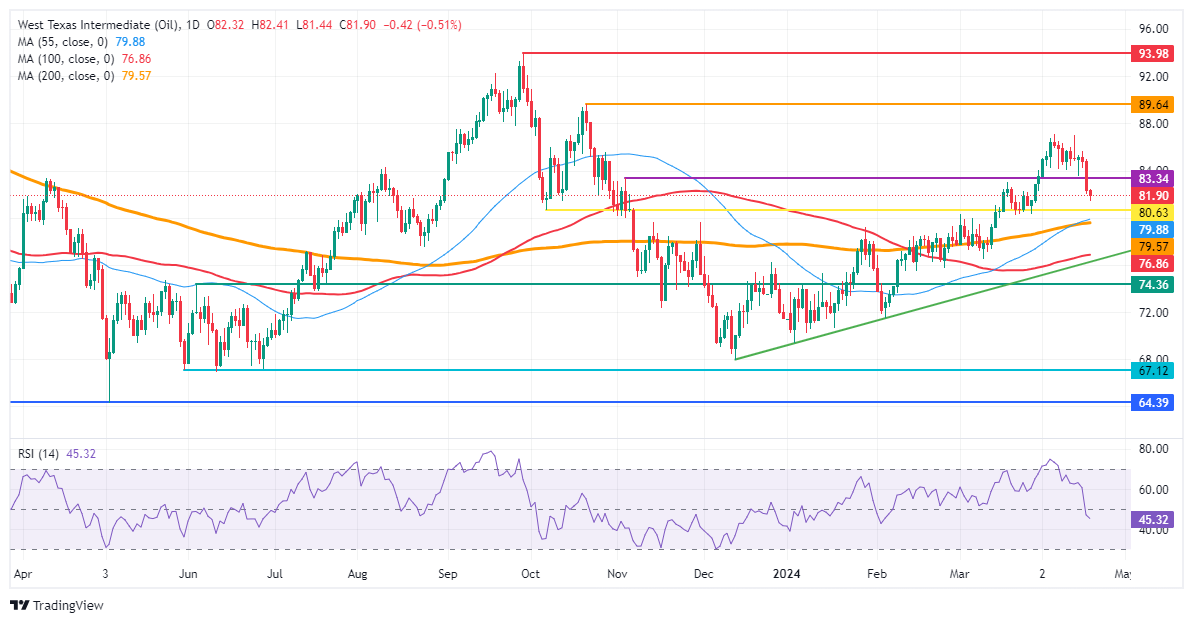- WTI Oil sell-off gets nearly fully erased at the start of the US trading session.
- Oil prices earlier broke below the pivotal $83.34 level, heading abck to $82.00
- The US Dollar Index pops back above 106.00 on upbeat Jobless Claims data.
Oil prices are erasing earlier losses after harsh rhetoric from Iran which said it is ready to respond when Israel should retaliate. More specific, Iran vowed to target several nuclear sites in Israel, which would mean substantial damage on the ground and in the region. Tensions and tit-for-tat headlines are spiraling yet again out of control, and the added sanctions from the US on Venezuela, Iran, and tariffs on China steel and aluminium are further driving up uncertainy and geopolitical tail risk.
The US Dollar, meanwhile, is having a change of heart as well, turning back in the green after yet again upbeat US data and beat on estimates across the board. Overnight several central banks had issued concerns on the strong US Dollar. In Asia the Bank of Japan and the Bank of South Korea even took it a step further and issued a joint statement saying that the strong US Dollar is messing with their measures to tackle inflation, and a joint invertention might be needed in order to limit the inflation inflow for their depreciating local currency against the Greenback.
Crude Oil (WTI) trades at $82.13 and Brent Crude at $86.56 at the time of writing.
Oil news and market movers: Headline risk remains live
- Recent data shows that Iran is exporting the highest amount of Oil in more than six years, the Financial Times reports.
- China is set to have a surplus of Oil production, expanding to 82m tons by 2030, according to Li Ran, a researcher at CNPC’s Economics & Technology Research Institute. This surplus would make up for any shortfall in the markets from OPEC and other suppliers.
- Leading Goldman Sachs Analyst Daan Struyven sees $90 as a ceiling for Brent Crude.
- The recent Crude Oil Inventories report from the US Energy Information Administration (EIA) showed that the Gulf Coast stockpiles are at their highest level in a year. Us Inventories grew by 2.74 million barrels, the highest since June 2023.
Oil Technical Analysis: Domino's wobble
Oil prices are not rallying despite the current stance from the Biden administration with sanctions being slapped on Venezuela and are set to be issued for Iran, which should be rather supportive for Oil prices. On the production front, Iran is number 3 and Venezuela is number 9 on oil production volumes within OPEC. Sanctions on Iran thus might be having a heavier impact on prices than the ones for Venezuela, which means the Biden administration will probably sanction non-oil sectors in order to avoid disruptions in the global Oil supply.
With geopolitical tensions lingering, the $83.34 and $90 handle should remain in grasp. One small barrier in the way is $89.64, the peak from October 20. In case of further escalating tensions in the Middle East, expect even $94 to become a possibility, and a fresh 18-month high could be on the cards.
On the downside, $80.63 is the next candidate as a pivotal supportive level. A touch softer, the convergence with the 55-day and the 200-day Simple Moving Averages (SMAs) at $79.88 and $79.57 should halt any further downturn.
US WTI Crude Oil: Daily Chart
WTI Oil FAQs
WTI Oil is a type of Crude Oil sold on international markets. The WTI stands for West Texas Intermediate, one of three major types including Brent and Dubai Crude. WTI is also referred to as “light” and “sweet” because of its relatively low gravity and sulfur content respectively. It is considered a high quality Oil that is easily refined. It is sourced in the United States and distributed via the Cushing hub, which is considered “The Pipeline Crossroads of the World”. It is a benchmark for the Oil market and WTI price is frequently quoted in the media.
Like all assets, supply and demand are the key drivers of WTI Oil price. As such, global growth can be a driver of increased demand and vice versa for weak global growth. Political instability, wars, and sanctions can disrupt supply and impact prices. The decisions of OPEC, a group of major Oil-producing countries, is another key driver of price. The value of the US Dollar influences the price of WTI Crude Oil, since Oil is predominantly traded in US Dollars, thus a weaker US Dollar can make Oil more affordable and vice versa.
The weekly Oil inventory reports published by the American Petroleum Institute (API) and the Energy Information Agency (EIA) impact the price of WTI Oil. Changes in inventories reflect fluctuating supply and demand. If the data shows a drop in inventories it can indicate increased demand, pushing up Oil price. Higher inventories can reflect increased supply, pushing down prices. API’s report is published every Tuesday and EIA’s the day after. Their results are usually similar, falling within 1% of each other 75% of the time. The EIA data is considered more reliable, since it is a government agency.
OPEC (Organization of the Petroleum Exporting Countries) is a group of 13 Oil-producing nations who collectively decide production quotas for member countries at twice-yearly meetings. Their decisions often impact WTI Oil prices. When OPEC decides to lower quotas, it can tighten supply, pushing up Oil prices. When OPEC increases production, it has the opposite effect. OPEC+ refers to an expanded group that includes ten extra non-OPEC members, the most notable of which is Russia.
Information on these pages contains forward-looking statements that involve risks and uncertainties. Markets and instruments profiled on this page are for informational purposes only and should not in any way come across as a recommendation to buy or sell in these assets. You should do your own thorough research before making any investment decisions. FXStreet does not in any way guarantee that this information is free from mistakes, errors, or material misstatements. It also does not guarantee that this information is of a timely nature. Investing in Open Markets involves a great deal of risk, including the loss of all or a portion of your investment, as well as emotional distress. All risks, losses and costs associated with investing, including total loss of principal, are your responsibility. The views and opinions expressed in this article are those of the authors and do not necessarily reflect the official policy or position of FXStreet nor its advertisers. The author will not be held responsible for information that is found at the end of links posted on this page.
If not otherwise explicitly mentioned in the body of the article, at the time of writing, the author has no position in any stock mentioned in this article and no business relationship with any company mentioned. The author has not received compensation for writing this article, other than from FXStreet.
FXStreet and the author do not provide personalized recommendations. The author makes no representations as to the accuracy, completeness, or suitability of this information. FXStreet and the author will not be liable for any errors, omissions or any losses, injuries or damages arising from this information and its display or use. Errors and omissions excepted.
The author and FXStreet are not registered investment advisors and nothing in this article is intended to be investment advice.
Recommended content
Editors’ Picks

EUR/USD trades sideways below 1.0450 amid quiet markets
EUR/USD defends gains below 1.0450 in European trading on Monday. Thin trading heading into the Xmas holiday and a modest US Dollar rebound leaves the pair in a familair range. Meanwhile, ECB President Lagarde's comments fail to impress the Euro.

GBP/USD stays defensive below 1.2600 after UK Q3 GDP revision
GBP/USD trades on the defensive below 1.2600 in the European session on Monday. The pair holds lower ground following the downward revision to the third-quarter UK GDP data, which weighs negatively on the Pound Sterling amid a broad US Dollar uptick.

Gold price holds comfortably above $2,600 mark; lacks bullish conviction
Gold price oscillates in a range at the start of a new week amid mixed fundamental cues. Geopolitical risks continue to underpin the XAU/USD amid subdued US Dollar price action. The Fed’s hawkish stance backs elevated US bond yields and caps the pair’s gains.

The US Dollar ends the year on a strong note
The US Dollar ends the year on a strong note, hitting two-year highs at 108.45. The Fed expects a 50-point rate cut for the full year 2025 versus 4 cuts one quarter earlier, citing higher inflation forecasts and a stubbornly strong labour market.

Bank of England stays on hold, but a dovish front is building
Bank of England rates were maintained at 4.75% today, in line with expectations. However, the 6-3 vote split sent a moderately dovish signal to markets, prompting some dovish repricing and a weaker pound. We remain more dovish than market pricing for 2025.

Best Forex Brokers with Low Spreads
VERIFIED Low spreads are crucial for reducing trading costs. Explore top Forex brokers offering competitive spreads and high leverage. Compare options for EUR/USD, GBP/USD, USD/JPY, and Gold.
